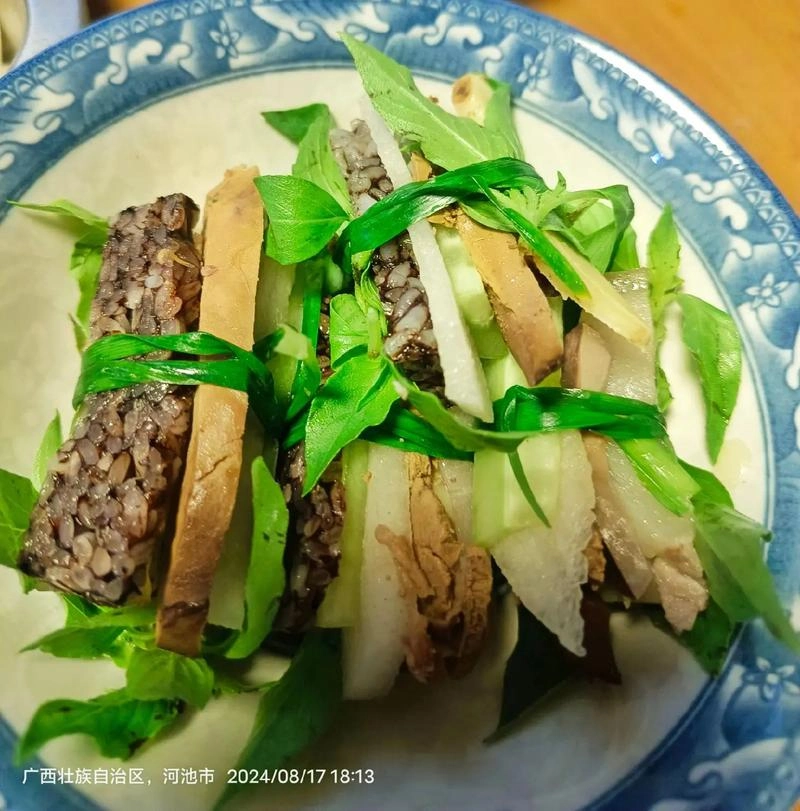The Culinary Delights of Duck Blood and Ferns: A Taste of Hechi’s Unique Cuisine
Introduction:
As a food connoisseur and practitioner, I am always on the lookout for unique and authentic flavors that can transport one’s taste buds to new horizons. Today, I invite you to embark on a gastronomic journey to Hechi, a city in the Guangxi Zhuang Autonomous Region of China, where a traditional dish made from duck blood, ferns, and wild vegetables like “Lei Gong Gen” (also known as potherb mustard) is cherished for its distinctive taste and cultural significance.
Origin and Cultural Background:
The dish, known locally as “Duck Blood with Ferns and Wild Greens,” has its roots deeply embedded in the rural culinary traditions of Hechi. It is a testament to the resourcefulness and creativity of the local people, who have long relied on the natural bounty of their surroundings. The use of duck blood is not only a nod to the region’s poultry farming but also a means to utilize every part of the animal, reflecting a sustainable and holistic approach to food.
Ingredients and Preparation:
The dish begins with the procurement of fresh, high-quality ingredients. The duck blood is sourced from local farms, ensuring its freshness and purity. Ferns, known for their crunchy texture, are meticulously selected for their tender shoots, while “Lei Gong Gen” and other wild vegetables are gathered at their peak, imbuing the dish with a burst of natural flavors.
To prepare the dish, the duck blood is first gently simmered to retain its smoothness. The ferns and wild greens are blanched to remove any bitterness and to enhance their color and texture. These ingredients are then combined in a rich broth, seasoned with a blend of traditional Chinese spices and herbs that harmoniously marry the robust flavors of the blood with the delicate essence of the greens.
Taste and Texture:
The resulting dish is a symphony of textures and flavors. The duck blood, with its velvety smoothness, contrasts beautifully with the crispness of the ferns and the slightly bitter, yet refreshing taste of the wild vegetables. The broth, infused with the essence of the greens and the depth of the spices, provides a rich and satisfying backdrop to the dish.
Visual Description:
Aesthetically, the dish is a feast for the eyes. The deep red of the duck blood stands out against the vibrant green of the ferns and wild vegetables, creating a visually striking and appetizing presentation. The dish is often garnished with a sprinkle of fresh herbs and a drizzle of aromatic oils, adding a final touch of elegance.
Representative Dishes and Cuisine:
In Hechi, this dish is often served as a main course, accompanied by steamed rice or local flatbreads. It can also be a part of a larger spread during festive occasions or family gatherings, showcasing the region’s love for hearty, home-cooked meals.
Culinary Characteristics:
The unique culinary characteristics of “Duck Blood with Ferns and Wild Greens” lie in its balance of flavors and textures. The richness of the duck blood is countered by the freshness of the greens, creating a dish that is both comforting and invigorating. It is a testament to the region’s culinary ingenuity and its deep connection with the natural environment.
Conclusion:
As a food professional, I am always eager to share and celebrate the diverse culinary traditions of different regions. Hechi’s “Duck Blood with Ferns and Wild Greens” is a shining example of how local ingredients and traditional cooking methods can create a dish that is not only delicious but also deeply rooted in the culture and history of the place. It is a dish that invites you to savor the flavors of Hechi and to appreciate the art of cooking with what nature provides.
